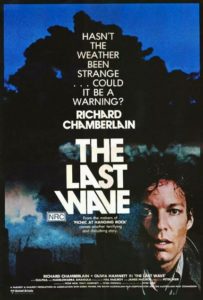 Australian director Peter Weir’s follow-up to his masterful PICNIC AT HANGING ROCK was this dreamlike exercise in apocalyptic fantasy that’s nearly as powerful as the earlier film. It’s certainly one the most interesting films Weir has ever made, making me wish he’d done more in the horror genre.
Australian director Peter Weir’s follow-up to his masterful PICNIC AT HANGING ROCK was this dreamlike exercise in apocalyptic fantasy that’s nearly as powerful as the earlier film. It’s certainly one the most interesting films Weir has ever made, making me wish he’d done more in the horror genre.
By an odd quirk of fate, 1977’s THE LAST WAVE ended up released in the U.S. before PICNIC AT HANGING ROCK (and also before Weir’s first film, 1974’s THE CARS THAT ATE PARIS). The two films, together with Weir’s darkly comedic suspense drama THE PLUMBER (made for Australian television in 1980), demonstrate a real knack for genre filmmaking, but unfortunately Weir now devotes his time to Hollywood dramedies (DEAD POETS SOCIETY, GREEN CARD, THE TRUMAN SHOW) and Oscar-grabbers (WITNESS, MASTER AND COMMANDER).
One more thing: THE LAST WAVE, like PICNIC AT HANGING ROCK before it, was subjected to some retrospective reediting by Weir in 2000, meaning the version currently available on DVD is different from the original release. But unlike PICNIC, from which Weir eliminated an entire subplot, THE LAST WAVE has been left relatively intact. The most notable change is in the final shots, rearranged so that the film now ends with a close-up of the lead actor Richard Chamberlain (whereas it originally concluded with snippets of the titular wave in action), which if you ask me is an improvement.
Australia is afflicted by a spate of catastrophic weather conditions, including a hailstorm and several freak downpours. David Burton, a Sydney based lawyer, is one of many residents affected by the weather; it appears to trigger a series of troubling dreams involving rains of frogs and a mysterious Aborigine man.
David’s latest case involves a band of Aborigines accused of killing a man not part of their tribe. From the start David believes the Aborigines he’s charged with defending—whose ranks include an enigmatic man named Chris Lee, who happens to be the figure from David’s dreams—are hiding something. David invites Chris to dinner one night, and Chris brings along Charlie, a non-English speaking tribal elder. Over dinner Chris reveals that for Aborigines the law passed down from their ancestors is more important than anything else; this is apparently why they killed the man, and also why they won’t divulge the full details of the crime. David discusses his dreams with Chris, who informs him that for Aborigines “a dream is the shadow of something real.”
As the film goes on, however, it becomes increasingly difficult to tell dream from reality. Among other oddities, Charlie turns up outside David’s house one night and then abruptly vanishes, and water spews from David’s car radio. The mystery is finally resolved during a particularly stormy night when Chris shows up to lead David into the sewers beneath Sydney, where David learns of an apocalyptic calamity set to occur in the (very) near future.
In THE LAST WAVE Peter Weir seems primarily interested in illuminating the Aboriginal concept of “Dreamtime,” a spiritual realm where normal laws don’t apply. Thus the narrative involving the Aborigine trial is largely an afterthought, with the majority of Weir’s attention focused on the increasingly hallucinatory atmosphere.
The film opens with a disturbing bit of mayhem involving a hail storm emitting from a cloudless sky that nearly destroys a rural schoolhouse. Most of the rest of the film is quiet and controlled, albeit with a real sense of submerged unease. It helps that Weir is an uncommonly skilled filmmaker capable of making the most mundane images—such as a bathtub drain or an overhanging table lamp—appear suffused with menace. He also shows a real flair for surrealism, in quick but impacting glimpses of indoor rainstorms and an underwater street. The Aboriginal society depicted in the film feels authentic, as does the depiction of a centuries-old spiritual realm intersecting with our own.
I’m not sure, however, that the apocalyptic denouement indicated in the title does the film justice. With such a rich and haunting tapestry one can’t help but feel a mite let down by the way it all leads up to a comparatively conventional threat to humanity (or at least Australia) in the form of a big wave. Still, the sewer-set climax, in which the protagonist discovers a ceramic mask of his own face, is marvelous, and the final shots of the titular destroyer are conveyed in an appropriately hallucinatory manner.
Vital Statistics
THE LAST WAVE
United Artists
Director: Peter Weir
Producer: Hal McElroy, James McElroy
Screenplay: Peter Weir, Tony Morphett, Petru Popescu
Cinematography: Russell Boyd
Editing: Max Lemon
Cast: Richard Chamberlain, Olivia Hamnett, David Gulpilil, Nandjiwarra Amagula, Vivean Gray, Frederick Parslow, Hedley Cullen, Jo England, Richard Henderson, Penny Leach, Peter Carroll, Athol Compton, Katrina Sedgwick, Ingrid Weir
